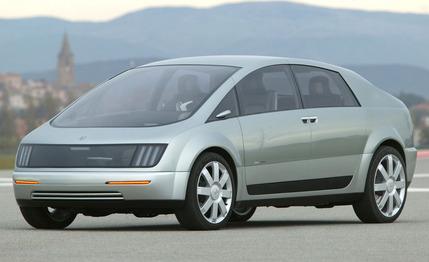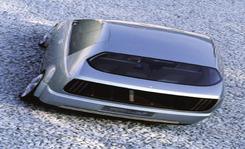
 First Drive Review
First Drive Review
We've driven the car of the future. It doesn't fly, it doesn't drive itself, and it looks like a car instead of some outrageous GM Motorama dream machine such as the winged, finned, turbine-powered Firebirds of yore. This one is serious, in keeping with the serious cash GM is investing ("hundreds of millions," they say) in a program that has generated 30-plus patents to date. The Hy-wire, which was shown at the Paris auto show last fall, is the running proof-of-concept incarnation of the AUTOnomy concept from the 2002 Detroit show and as such offers a view of the future through three portals.
First, there's the idea of the high-value, long-lasting, fully integrated "skateboard" running chassis, to which a wide range of bodies could be docked. Next, there's the drive-by-wire control system. And finally, there's the hydrogen fuel-cell powertrain. These concepts will likely arrive one at a time on different vehicles, but the crystal-ball folks at GM have integrated them here.
The skateboard concept promises a low, Corvettelike center of gravity for improved handling and unlimited packaging flexibility in the bodywork. Concentrating the high-investment mechanicals into a chassis with a 20-year life span permits the body to become a high-profit fashion item in which the form is constrained by far fewer functional boundaries. Drive-by-wire permits the driver to sit on the right or left, control feel can be tailored to the driver's tastes or mood, and it's an enabler for technologies such as automated highways. And the hydrogen-powered fuel cell, which emits only water, promises to distance the automobile from the environmental debate and partly insulate the auto industry from unpredictable fluctuations in the oil industry (most hydrogen is produced from domestic natural gas). That's a lot of hope packed into one 4200-pound concept car.


The Hy-wire's snap-on body offers an airy, luxurious environment for five with open areas from the seats forward to the nose and rearward to the tail. It attaches via 10 mounting points (plus one electrical connector) to an all-aluminum, control-arm-suspended rolling chassis that is 11 inches thick. It packages a 94-kW fuel cell, which draws hydrogen from three 5000-psi compressed-hydrogen tanks to power an 80-hp electric motor driving the front wheels. The tanks hold 4.4 pounds of hydrogen (containing the energy equivalent of two gallons of gas) good for an 80-mile range. Motors in each wheel and 10,000-psi tanks are but a few of the improvements expected to lead to a six-inch-thick skateboard chassis with a 170-mile range.
Hydrogen Today
There are no booster batteries onboard, so there is no regenerative braking. This was done partly to conserve weight and package space and also to illustrate that the fuel cell can produce sufficient electricity on demand. We're not entirely convinced of this argument. Step-off is lively, as in any electric car (peak torque is at 0 rpm), but the Hy-wire seemed to experience some lag, especially when accelerating as if to pass. Order up acceleration, and one can hear the air compressor and the various hydrogen control valves clicking over the whir of the drive motor. Acceleration is a leisurely 10 seconds to 40 mph.
The Swedish firm SKF engineered the Hy-wire's drive-by-wire system using much of the same hardware found in the Bertone Filo concept (Upfront, November 2001) but with greatly improved software. Two twist grips arranged like an airplane's control yoke manage the steering, the braking, and the acceleration. To accelerate, twist the grips, knuckles back as on a motorcycle; squeeze the grips for braking; and steer them through just 20 degrees to hang a U-ey.